Tuesday 10 August, 2010, 05:17 - Broadcasting
Posted by Administrator
One of the most common questions that the Wireless Waffle team are asked by those setting up radio transmitters is, "How much power do I need to cover an area X miles wide?". Such a question is virtually unanswerable as there are so many factors to take account of including the frequency of operation, the topography of the area, the kind of structures (buildings, trees) which are in the required coverage area, what kind of receivers people are using and much more. The observant will note that these factors are not ones which can necessarily be changed by the person operating the transmitter - unless they fancied chopping down a forest for example. What can be changed at the transmitting site are two relatively simple factors: the height of the antenna, and the power of the transmitter.Posted by Administrator
Such discussions therefore end up focussing on how high the antenna needs to be and what power the transmitter should be. But which is most effective in increasing coverage: height or power?
Let's tackle height first. Assuming we are trying to provide a signal over the earth and that there are no obstacles at all and that the earth has no undulations (hills and so on), then the range of a transmitter can easily be calculated from a simple line-of-sight rule. This tells us that for a particular height above the ground, the horizon (and thus the edge of the coverage area) will be a specific distance away. One oddity in this is that radio signals tend to get defracted a little by the Earth's atmosphere which has the effect of making the planet appear slightly less curved and thus extends the radio horizon about a third beyond the optical horizon. The chart below shows the optical and radio horizons for a transmitting antenna mounted at a certain height.
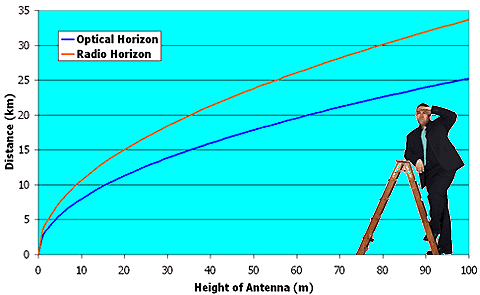
With an antenna about 10 metres above the ground, the radio horizon is about 10km away. If the height of the antenna is increased to 50 metres, the radio horizon increases to about 24 km - a very healthy improvement. It's perhaps worth noting that 'height above ground' could be generated by raising the height of the antenna, or by mounting it on top of heigh point (eg a hill).
Increasing the transmitter power also increases coverage, but not in quite the same way. Getting signals much beyond the radio horizon relies on various odd propagation techniques including refraction, defraction and scatter. In free space, increasing the power by a factor of 2 will increase the distance at which the signal is of equal strength by the square root of 2. So, if the signal is 30 dB at a distance of 10km, increasing the power by a factor of 2 will move the point at which the signal is 30 dB to a point approximately 14km away from the transmitter. Sadly, the Earth is not generally a 'free space' environment and signals fall away much quicker than this, even before the horizon is reached. The chart below shows a simulation of coverage for different transmitter powers, assuming an antenna height of 20 metres.
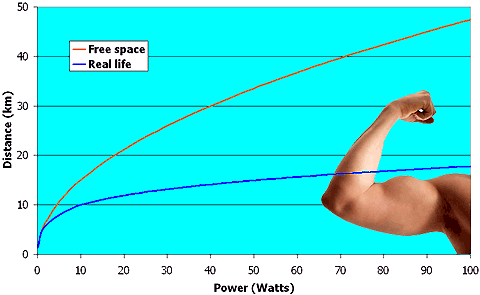
The distance to the radio horizon for a 20 metre heigh aerial is 15 km and in 'free space', in this example, this is reached by a power of 10 Watts. For the 'real life' example, 10 Watts only achieves a distance of around 10 km because of the fact that the Earth is not a free space environment. To achieve 15 km in 'real life' requires a power of nearer 50 Watts. What is immediately clear is that enormous increases in power are required to extend coverage. Even with 100 Watts, in our theoretical example, the distance acheived is still less than 20 km.
Increasing the height of the transmitting antenna is therefore, theoretically, a much more effective way of increasing coverage than turning up the power. Of course, it's not always possible to put up a high antenna, and in this situation more power is clearly better, but in general height wins every time. To show the difference, the map below (made using Radiomobile) shows the coverage for a transmitter nominally located in the centre of Oxford. It's animated (oo-err!) and cycles through the coverage which would be acheived for:
* A 10 Watt transmitter with an antenna height of 10 metres
* A 40 Watt transmitter with an antenna height of 10 metres
* A 10 Watt transmitter with an antenna height of 20 metres
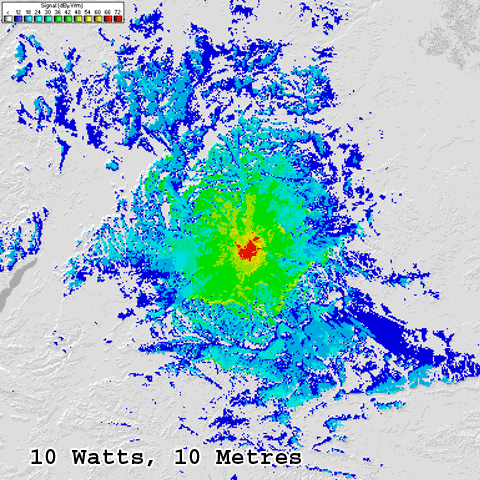
 The coverage achieved in the latter two cases is very similar, however in the map with the higher antenna, the coverage is more 'solid' than that with higher power. If this were a radio station, the higher antenna would provide a more reliable signal, especially for people on the move, than the lower antenna with higher power. The extent of the advantage of height over power means that it is generally more beneficial to identify an elevated transmitter site towards the edge of an area where coverage is required, rather than settle for one which is nearer the centre but lower. A transmitter on a hill overlooking a town will provide more solid coverage in the town for the same transmitter power than a site in a town centre. Hopefully, those now considering how best to maximise their coverage will think beyond Watts and consider that factor well understood by estate agents, location, location, location.
The coverage achieved in the latter two cases is very similar, however in the map with the higher antenna, the coverage is more 'solid' than that with higher power. If this were a radio station, the higher antenna would provide a more reliable signal, especially for people on the move, than the lower antenna with higher power. The extent of the advantage of height over power means that it is generally more beneficial to identify an elevated transmitter site towards the edge of an area where coverage is required, rather than settle for one which is nearer the centre but lower. A transmitter on a hill overlooking a town will provide more solid coverage in the town for the same transmitter power than a site in a town centre. Hopefully, those now considering how best to maximise their coverage will think beyond Watts and consider that factor well understood by estate agents, location, location, location.2 comments
( 3188 views )
| permalink
| 



 ( 3.1 / 83832 )
( 3.1 / 83832 )




 ( 3.1 / 83832 )
( 3.1 / 83832 )
Thursday 1 April, 2010, 08:04 - Pirate/Clandestine
Posted by Administrator
Posted by Administrator
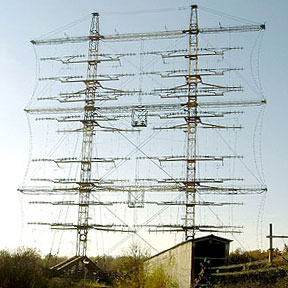 There is endless speculation on the internet as to what became of the many pirate radio ships which sailed the seven seas (or the North Sea more specifically) in the bygone era. Wireless Waffle can exclusively reveal the final resting home of one of these infamous nafarious vessels, having been tipped off by a Government source who wishes to remain anonymous. 'Dave Herrish' for want of a better name (and a complete lack of imagination on our part) has informed us that the rigging that adorned the pirate ship 'The Ross Communidel Amigocado' was removed from the hull at a secret military shipyard somewhere on the southern northern Europe coast and transported, piece by piece, to the facilites of Radio Bulgaria where it was re-assembled and used as a mast for their short-wave monitoring station.
There is endless speculation on the internet as to what became of the many pirate radio ships which sailed the seven seas (or the North Sea more specifically) in the bygone era. Wireless Waffle can exclusively reveal the final resting home of one of these infamous nafarious vessels, having been tipped off by a Government source who wishes to remain anonymous. 'Dave Herrish' for want of a better name (and a complete lack of imagination on our part) has informed us that the rigging that adorned the pirate ship 'The Ross Communidel Amigocado' was removed from the hull at a secret military shipyard somewhere on the southern northern Europe coast and transported, piece by piece, to the facilites of Radio Bulgaria where it was re-assembled and used as a mast for their short-wave monitoring station.Situated between Varna and Dolni Chiflik the antennas are now used as a high gain array for the purposes of intercepting both civil and military radio traffic. But, twice a year, in what must be one of the most ironic celebrations in Europe, the station is opened to the public whereupon bunting and other maritime flags are fastened and festooned to the antennas and small children are allowed to climb up and pretend to be seafaring pirates.
Unbeknownst to many of these children, the Bulgarian phrase for 'I am a pirate', which is 'Лиц ентура дёка ролаян' transliterates as 'lits entura dyohka rolayan' (try saying it out loud), which is often heard being screeched loudly across the countryside accompanied by the ringing of ships bells. Ding dong!
Friday 1 January, 2010, 00:14 - Pirate/Clandestine
Posted by Administrator
Regulars to the pages of Wireless Waffle will realise that we have an inate (or should that be 'inert') fascination with short wave radio. And nothing is more mysterious and intriguing on short wave than the many spy broadcasts which usually take the form of a string of numbers or letters read out in a mechanical fashion by a pre-recorded male or female voice. A bit like the speaking clock for spooks.Posted by Administrator
 One of the most famous spy stations, the Lincolnshire Poacher (which was allegedly broadcast from Cyprus), ceased transmissions in 2008 and it rumour has it that its sister station, Cherry Ripe (latterly broadcast from Australia) also ceased transmissions towards the end of 2009. Which leaves fans of these funky but furtive broadcasts with a big hole in their social calendar (not that such fans had much of a social calendar to begin with).
One of the most famous spy stations, the Lincolnshire Poacher (which was allegedly broadcast from Cyprus), ceased transmissions in 2008 and it rumour has it that its sister station, Cherry Ripe (latterly broadcast from Australia) also ceased transmissions towards the end of 2009. Which leaves fans of these funky but furtive broadcasts with a big hole in their social calendar (not that such fans had much of a social calendar to begin with).But all is not lost. Thanks to the Conet project and web designer Kevan Davis fans can now enjoy:
* Number Station Bingo
This excellent game will keep you occupied (but not in the same way as the US forces in Iraq) for literally minutes. If you win, it is customary to shout 'Badabingo, green stick in the green hole' though for security reasons we obviously cannot explain why this is so.
Tuesday 20 October, 2009, 14:29 - Pirate/Clandestine
Posted by Administrator
A previous article on Wireless Waffle talked about the chances of a pirate radio station being caught focussing on VHF FM pirates. A later one focussed on short-wave pirates and discussed which frequencies to avoid in order to minimise getting the authorities' collective danders up.Posted by Administrator
Over the past 12 months, both Premier Radio (who used 6265 kHz) and Laser Hot Hits (who used 4025 kHz) have had their transmitter sites raided. Bringing together the ethos of the two previous articles, it would make sense that in order for a raid to be worthwhile, even at short-wave, there would have likely been a complaint raised against the station concerned.
So we might, therefore, ask, "Who raised these complaints?" It seems unlikely that major international broadcasters such as the BBC World Service or China Radio International would be at all threatened by pirate operators taking their audience away or causing interference, especially as the frequencies being used by the pirates are not ones being used by an international broadcaster at the time, so there must be another source of complaints.
Across Europe (and indeed the world) there are a series of short-wave (HF) monitoring stations operated by the various national regulatory administrations who produce quarterly reports on their monitoring activities. The purpose of the monitoring and the associated reports is, on the one hand, to check on legitimate users of the HF spectrum, and on the other to identify use which is in contravention to the ITU's rules on spectrum usage. Where an administration identifies contravening transmissions, it can flag these in the reports and, according to the ITU document describing the reports, these will then be forwarded to the administration which is the source of the transmission.
Looking through these reports for the past 12 months (eg from October 2008 to September 2009), there are a number which relate to various short wave pirates. Specifically:
| Date | Time (UTC) | Freq (kHz) | Monitoring Station | Transmitter Location | Station* | Complaint |
|---|---|---|---|---|---|---|
| 24 Oct 08 | 1700-2359 | 4024.57 | Rambouillet, France | UK | Laser Hot Hits | Illegal use of frequency |
| 25 Oct 08 | 0000-0600 | 4024.57 | Rambouillet, France | UK | Laser Hot Hits | Illegal use of frequency |
| 11 Nov 08 | 0000-0645 | 4024.58 | Berlin, Germany | UK | Laser Hot Hits | None |
| 5 Dec 08 | 0204-0400 | 4024.60 | Tarnok, Hungary | Not Identified | Laser Hot Hits | Broadcast in non broadcast band |
| 4 Apr 09 | 1715-2400 | 4025.00 | Berlin, Germany | UK | Laser Hot Hits | Broadcast in non broadcast band |
| 7 Nov 08 | 1837-2359 | 5800.00 | Rambouillet, France | 8E54 45N29 (Milan, Italy) | PLAYBACK INTL | Broadcast in non broadcast band |
| 12 Jul 09 | 0855-1000 | 5751.51 | Rambouillet, France | 1W31 51N15 (Andover, UK) | Best of British Radio | Illegal use of frequency |
| 8 Nov 08 | 0000-0200 | 5800.00 | Rambouillet, France | 8E49 45N23 (Milan, Italy) | PLAYBACK INTL | Broadcast in non broadcast band |
| 10 Nov 08 | 2020-2100 | 5800.00 | Tarnok, Hungary | Not Identified | Playback International | Broadcast in non broadcast band |
| 4 Jan 09 | 1249-1300 | 5801.00 | Vienna, Austria | Italy | MILANO (Playback International) | Broadcast in non broadcast band |
| 24 Oct 08 | 2215-0000 | 5803.00 | Baldock, UK | 8E7 45N56 (Milan, Italy) | Playback International | None |
| 12 Oct 08 | 0700-0830 | 5805.03 | Tarnok, Hungary | Not Identified | Orion Radio | Broadcast in non broadcast band |
| 2 Dec 08 | 1642 | 6210.00 | Baldock, UK | Belgium | RADIO BORDERHUNTER | SW Pirate |
| 12 Apr 09 | 1345 | 6202.00 | Baldock, UK | 8E48 50N15 (Frankfurt, Germany) | Crazy Wave Radio | Non-Conformity RR.5 |
| 15 Feb 09 | 0949-1120 | 6219.99 | Vienna, Austria | Italy | MYSTERY RADIO | Broadcast in non broadcast band |
| 15 Feb 09 | 1356-1429 | 6219.99 | Vienna, Austria | Italy | PLAYBACK | Broadcast in non broadcast band |
| 12 Apr 09 | 1815 | 6220.00 | Baldock, UK | 10E0 43N50 (Italy) | MYSTERY RADIO | Non-Conformity RR.5 |
| 9 May 09 | 1855-1921 | 6220.00 | Vienna, Austria | Italy | MYSTERY RADIO | Broadcast in non broadcast band |
| 11 Jul 09 | 1935-2300 | 6220.00 | El Casar, Egypt | 11E24 44N27 (Bologna, Italy) | Mystery Radio | None |
| 31 Jul 09 | 0000-0030 | 6220.00 | Klagenfurt, Austria | Pisa, Italy | Mystery Radio | Broadcast in non broadcast band |
| 6 Jan 09 | 0105 | 6240.00 | Baldock, UK | Netherlands | UNDERGROUND RADIO | Illicit |
| 17 Feb 09 | 1654 | 6240.00 | Baldock, UK | Netherlands | UNDERGROUND RADIO | Illicit |
| 5 Jun 09 | 2340 | 6420.25 | Baldock, UK | 4E46 51N38 (Breda, Netherlands) | Casanova or Dutchwing? | Pirate Station |
| 7 Feb 09 | 1657 | 6870.00 | Baldock, UK | 12E20 42N41 (Terni, Italy) | Playback International | Non-Conformity RR.5 |
| 30 Apr 09 | 1639 | 6870.00 | Baldock, UK | 12E20 42N41 (Terni, Italy) | Playback International | Non-Conformity RR.5 |
| 8 Feb 09 | 0857-0933 | 6870.00 | Vienna, Austria | 9E38 45N41 (Bergamo, Italy) | PLAYBACK | Broadcast in non broadcast band |
| 22 Mar 09 | 0956-1429 | 6870.00 | Vienna, Austria | Italy | PLAYBACK | Broadcast in non broadcast band |
| 3 May 09 | 0845-0940 | 6870.00 | Vienna, Austria | Italy | PLAYBACK | Broadcast in non broadcast band |
| 4 July 09 | 2001-2017 | 6870.00 | Vienna, Austria | Italy | PLAYBACK | Broadcast in non broadcast band |
| 12 Jul 09 | 0430-2200 | 6870.00 | Tarnok, Hungary | USA (!) | PLAYBACK INT. RADIO | Broadcast in non broadcast band |
| 14 Feb 09 | 1425-1443 | 6878.00 | Vienna, Austria | Italy | PLAYBACK | Broadcast in non broadcast band |
| 21 Feb 09 | 0700-2040 | 6880.00 | Rambouillet, France | 9E54 44N42 (Genova, Italy) | Playback International | Illegal use of frequency |
| 22 Feb 09 | 0630-0700 | 6880.00 | Rambouillet, France | 11E33 44N21 (Bologna, Italy) | Playback International | Illegal use of frequency |
| 4 Oct 08 | 2000-2100 | 6925.00 | Rambouillet, France | 20E32 39N4 (Greece) | Spider Radio | Illegal use of frequency |
| 26 Jul 09 | 0000-1700 | 7550.00 | Tarnok, Hungary | Italy | Radio Amica | Broadcast in non broadcast band |
| 29 Aug 09 | 0620-0700 | 7550.00 | El Casar, Egypt | Italy | Radio Amica | None |
| 29 Aug 09 | 0600-0630 | 7550.00 | Klagenfurt, Austria | Italy | Radio Amica | Broadcast in non broadcast band |
| 18 Feb 09 | 1218-1220 | 9385.00 | CRMO, South Korea | Ireland | LASER HOT HITS | Illegal use of frequency |
| 19 Feb 09 | 1606-1607 | 9385.00 | CRMO, South Korea | Not Identified | Laser Hot Hits | Illegal use of frequency |
| 28 Feb 09 | 1130-1300 | 9385.00 | Tarnok, Hungary | Not Identified | Laser Hot Hits | Broadcast in non broadcast band |
* Where the station was identified in the monitoring report, it is shown in CAPITALS.
Where no name was given, it has been identified and added in by searching through various on-line logs from the date concerned.
In addition to the above there are one or two other unidentified broadcasts on typical pirate frequencies (eg 6447 kHz on 21 August 2009) but there does not seem to be any indication of who they might be (nor do logs help with this).
Clearly there has been a lot of monitoring of Laser Hot Hits going on by various administrations (Laser may be impressed that they were heard in South Korea!) Similarly Mystery Radio and Playback International have also been heavily monitored though the grid references given for their locations seems to vary quite a lot.
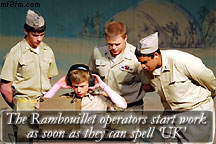 These stations operate over long periods, usually at weekends but outside these times too, so it is perhaps not surprising that they have been 'caught'. A more interesting question might be why other stations have been monitored. Was it a chance happening by the administration concerned, or are the frequencies they are using of particular interest to that country?
These stations operate over long periods, usually at weekends but outside these times too, so it is perhaps not surprising that they have been 'caught'. A more interesting question might be why other stations have been monitored. Was it a chance happening by the administration concerned, or are the frequencies they are using of particular interest to that country?There are many more questions that these logs raise: How many 'complaints' are necessary before action is taken? Are the locations produced sufficiently accurate to find the transmitters or are other methods necessary? Do the various monitoring stations co-operate to improve the accuracy of locations? Is there a competition between stations and administrations to show how 'bad' their neighbours are being (eg UK complaining about France and France complaining about UK). And perhaps, most importantly, how come Mystery and Playback are still on air?!


